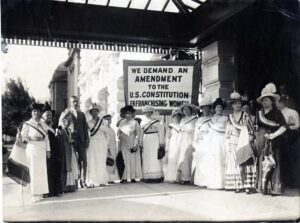Dramaturg's note by Sammy Daynes Utah women of the 19th century believed in many of the same doctrines that members of the Church of Jesus Christ of Latter-Day Saints believe in today. They also believed in and practiced the doctrine of polygamy, which was accepted as not only revelation from God but also an unremarkable way of life. Many women found happiness in plural marriages, formed close relationships with their sister wives and helped each other in raising children. One woman, after being proposed to, asked that the man marry both she and her sister. Hundreds of women accepted plural marriage- “some because they believed plural marriage was a glorious doctrine, others out of a hope for future exaltation or because conforming seemed a lesser idea than abandoning their homes and faith.”* To be a Mormon at this time meant to fight to practice your religion. The people were full of faith, because the very choice to be a Mormon was in effect equal to outcasting yourself from the rest of America. The rest of the country saw polygamy as a great evil, and as a result, Congress rescinded women’s right to vote, something that had already been permitted in the territory for 17 years. Utah was unique in the sheer number of women who campaigned for suffrage. Utah had a higher proportion of its population affiliated with the national women's suffrage unit than any other state or territory in the nation. Elizabeth Cady Stanton and other famous suffragettes came often to Utah and found the women there to be some of the most incessant campaigners for women’s votes in the country. A gathering of Utah suffragettes was called “one of the most remarkable, perhaps, that has ever congregated on the Continent. To see a mass of between 3,000 and 4,000 women…meeting together to advocate the claims of polygamy and defend the men who practice it.”* [caption id="attachment_7360" align="alignleft" width="300"]

(Courtesy of National Women’s Party) Local leaders in Utah encouraging rights of Women’s Suffrage[/caption] These women were full of faith and would not back down. In a New York Times editorial, a writer supposed that if women received the vote, they would use it to eliminate polygamy. No one suspected that the women would fight to defend it. Phebe Woodruff said that if Congress chose to imprison Mormon men they would have to “make their prisons large enough to hold their wives, for where they go we will go also.”* When Wilford Woodruff finally issued the manifesto advising the saints to desist in practicing polygamy, the reaction was mixed- some joyous, some sorrowful, most simply confused. If anything, it further spurred women in the fight for suffrage, and they were rewarded when Utah received statehood in 1896 and its constitution gave women the right not only to vote but also to hold office. Suffrage brings us right into the lives of two sister-wives who valued not only the vote but also their polygamous marriages. The struggle of Ruth and Frances to balance their faith, their freedom, and their responsibilities is one the play tackles with heartbreaking grace. Hearing their story reminds us that despite their wildly different circumstances, the women of the 19th century were very similar to Utah women today: fiercely loyal to their families, devoted to their faith, and avid supporters who lifted each other. **All quotes taken from A House Full of Females: Plural Marriage and Women’s Rights in Early Mormonism, 1835-1870 by Laurel Thatcher Ulrich


